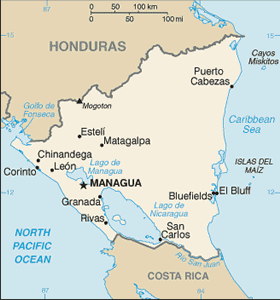The Geography of Nicaragua
The Geography of Nicaragua
Nicaraguan Geography
Location: Central America, bordering both the Caribbean Sea and the North Pacific Ocean, between Costa Rica and Honduras
Geographic coordinates: 13 00 N, 85 00 W
Map references: Central America and the Caribbean
Area: total: 129,494 sq km land: 120,254 sq km water: 9,240 sq km
Area - comparative: slightly smaller than New York state
Land boundaries: total: 1,231 km border countries: Costa Rica 309 km, Honduras 922 km
Coastline: 910 km
Maritime claims: territorial sea: 12 nm contiguous zone: 24 nm continental shelf: natural prolongation
Climate: tropical in lowlands, cooler in highlands
Terrain: extensive Atlantic coastal plains rising to central interior mountains; narrow Pacific coastal plain interrupted by volcanoes
Elevation extremes: lowest point: Pacific Ocean 0 m highest point: Mogoton 2,438 m
Natural resources: gold, silver, copper, tungsten, lead, zinc, timber, fish
Land use: arable land: 14.81% permanent crops: 1.82% other: 83.37% (2005)
Irrigated land: 610 sq km (2003)
Natural hazards: destructive earthquakes; volcanoes; landslides; extremely susceptible to hurricanes
Environment - current issues: deforestation; soil erosion; water pollution
Environment - international agreements: party to: Biodiversity, Climate Change, Climate Change-Kyoto Protocol, Desertification, Endangered Species, Environmental Modification, Hazardous Wastes, Law of the Sea, Ozone Layer Protection, Ship Pollution, Wetlands, Whaling signed, but not ratified: none of the selected agreements
Geography - note: largest country in Central America; contains the largest freshwater body in Central America, Lago de Nicaragua


